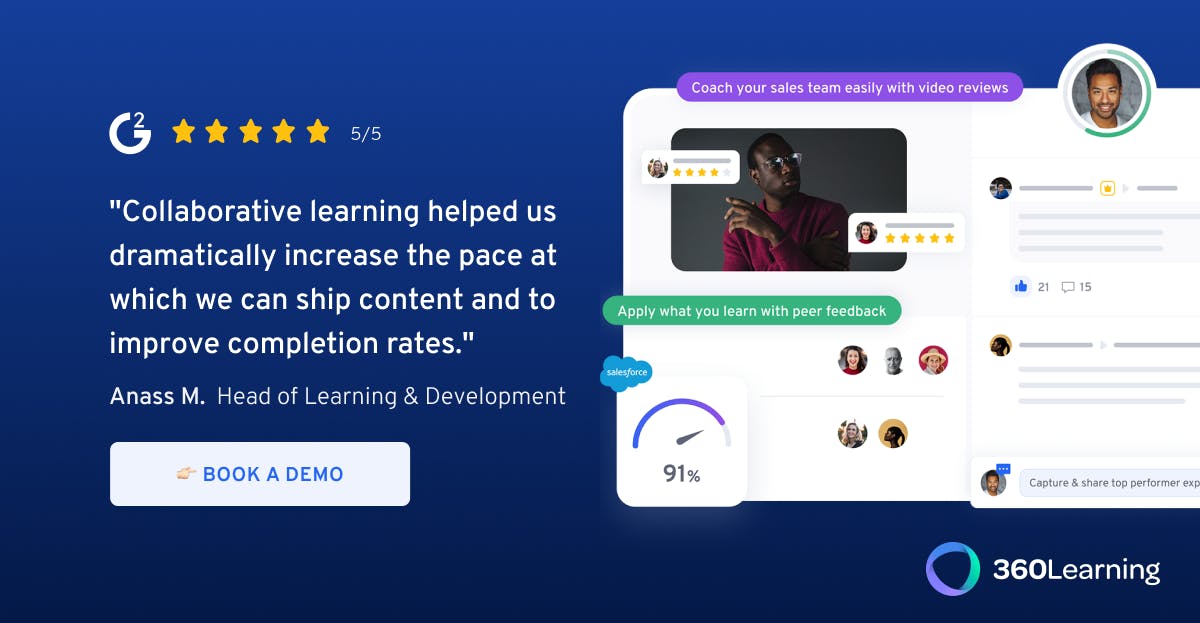Learning and Development (L&D) departments have their work cut out for them these days. The speed of business is accelerating, and work culture is evolving along with it. Companies frequently have to adjust to radical changes—like an emergency shift to remote work—almost overnight.
To support these business challenges, L&D programs need to be faster, more peer-driven, and capable of scaling. Collaborative Learning can help by creating a more democratic and decentralized learning culture within your company.
This might sound great in theory, but what does it look like in practice? To showcase the reality of Collaborative Learning, here are three powerful examples of top companies reaching their L&D objectives through democratized, simplified, and decentralized training approaches.
AlphaSights built a better onboarding program by democratizing course creation
The goal of AlphaSights is to unlock humanity’s collective knowledge to power progress for individuals, businesses, and society as a whole. The global research and information services company turned to Collaborative Learning to help them onboard new employees quickly as they rapidly scaled their global operations.
The challenge
AlphaSights is regularly ranked as one of the world’s fastest-growing companies, with 900+ employees around the globe. With such rapid expansion, they struggled to scale their onboarding courses and keep them up to date with the needs of their workforce.
To scale their L&D programs accordingly, AlphaSights needed a solution that allowed them to:
- Streamline their course creation process. They needed a faster and more streamlined system for creating and launching new courses.
- Leverage internal knowledge. The company knew that many of their employees were valuable subject-matter experts whose knowledge could be tapped to create more useful and relevant training materials.
- Ensure that all trainings would effectively engage their workforce. Employees don’t want to waste time with boring or irrelevant courses. AlphaSights needed to make sure every one of their courses was hitting the mark.
The solution
AlphaSights adopted Collaborative Learning to help them restructure their onboarding programs to be more dynamic and interactive.
A Collaborative Learning platform let them leverage their institutional knowledge by allowing internal subject-matter experts (like project managers or team leads) to author new courses on demand. Empowering these employees to contribute their specific skills and expertise during the course creation process helped to ensure all training materials were directly relevant. Plus, having more helping hands throughout the process meant that courses could be conceptualized, created, and shipped more quickly and efficiently than ever before.
By leveraging these internal experts, the L&D team transformed their two-week in-person onboarding course into a more engaging digital program. These new 15-hour digital training program and supplemental synchronous sessions offer more opportunities for employee feedback and engagement.
The impact
To track the success of this new Collaborative Learning strategy within the organization, the AlphaSights Professional Development team monitored course reactions, engagement, and exam results. They found that:
- 97% of in-course reactions were positive, indicating that new hires found the trainings useful and relevant.
- 98% of new hires felt that their digital training effectively prepared them for the collaborative live sessions.
- 99% of new hires found the digital training approach to be highly intuitive.
In addition, the AlphaSights team was able to onboard 240 subject-matter experts to contribute to these digital training programs. Subsequently, the team has launched an average of 27 new courses each month. Now AlphaSights can better meet learners’ needs with their democratized Collaborative Learning environment.
Read More: How AlphaSights built a scalable onboarding program with 99% satisfaction rates
Appen simplified its remote learning stack with a Collaborative Learning solution
Appen is a global company that collects and labels images, text, audio, video, and other data used to build and improve some of the world’s most innovative artificial intelligence (AI) systems. They provide their clients with the information they need to launch machine learning and AI tools in a multitude of industries, including the automotive sector, healthcare, financial services, and retail.
As Appen grew, their learning tool stack became increasingly fragmented and hard to manage. A Collaborative Learning solution helped them consolidate all their various functions in one intuitive tool.
The challenge
The Appen team works within an industry where technologies, competition, and go-to-markets constantly change and evolve. As such, Appen’s Learning and Development team must constantly adjust training programs to suit the introduction of new products, processes, and business priorities.
Specifically, the Appen team needed to develop a learning strategy that allowed them to:
- Reduce time spent onboarding new customers and employees. Every year, Appen hires 100+ employees and must onboard them in a highly distributed and global environment. Additionally, Appen’s Professional Services team was spending 12 hours onboarding each new client through face-to-face training.
- Consolidate their learning tool stack. As Appen (and the industry as a whole) continued to grow rapidly, the company’s L&D team recognized that their learning tool stack was becoming increasingly complex. For example, just to complete a data privacy training, employees had to use five different tools. This was causing confusion for learners, and was taking up an unnecessary amount of time.
Overall, the team needed to find the best way to streamline their L&D processes to give the company the agility they needed to keep up with the pace of business.
The solution
Appen simplified its tool stack by switching to an all-in-one Collaborative Learning tool.
Unlike many LMS and LXP tools that only support part of the learning process, a comprehensive Collaborative Learning platform allows Appen to support L&D, course creators, and learners all within the same system.
The result is sleeker and more efficient. Training module forums help reduce time spent onboarding new employees and customers by creating built-in collaborative feedback loops. Learners can raise questions in the forum where experts can answer them once for everyone, sparing the L&D team from addressing repetitive questions and giving new joiners the right information without having to take time out of their trainings.
Appen’s L&D team was also able to decentralize their content creation process by coaching subject-matter experts within the organization to create useful and relevant training materials. Now, Appen can train both employees and new customers on new releases and processes faster, using direct insights from the experts who know these releases and processes best.
The impact
By digitizing trainings, scaling the content creation process, and streamlining their onboarding processes, Appen saved 102 days of training in three months and reduced the time spent onboarding new clients by 50%. Not only does Collaborative Learning save time across the organization, but it also decreases ramp time for new employees and customers so they can feel fully confident and properly trained faster than before.
Additionally, the flexibility of the 360Learning Suite enables the Appen L&D team to address learning needs in real time and keeps everything consolidated in one place. For example, new Sales Enablement training empowers the team to practice pitches and demos and receive coaching remotely—all in a single platform.
Read More: How Appen saved $240K with Collaborative Learning
Flexport supported flexible growth and expansion with hybrid L&D
Flexport is a global company that ships freight by air, ocean, rail, and truck for some of the world’s largest brands. What makes Flexport different is its reliance on software throughout the shipment process, which gives its customers more transparency than traditional shipping and freight methods.
The challenge
Flexport needed to build a new global L&D team from the ground up. But first, they needed to settle on an organizational strategy. Both a centralized and a decentralized L&D structure had potential issues:
- A centralized approval process didn’t keep up with the company’s growth. Flexport’s company culture is hyper-growth focused. Because teams across the business like Sales, Engineering, and Finance operate at such rapid paces to keep up with the needs of the business, a solely centralized learning approach where everything runs through the company’s (very small) L&D team wasn’t scalable or feasible.
- A fully decentralized L&D system could lead to information silos and wasted time. On the other hand, Flexport also needed to incorporate some form of centralized learning to ensure that each team was set up with company-wide training guidelines and best practices coming directly from the L&D team. Up until this point, Flexport had a siloed approach to learning—each team was using different platforms and standards for training, which was leading to duplicated efforts across the business.
To overcome these challenges, Flexport's L&D strategy needed to strike the right balance between decentralized and centralized learning approaches.
The solution
Flexport created a hybrid solution that included elements of both centralized and decentralized learning.
Flexport’s L&D team takes on more of an advisory role to help organize each team’s specific training needs and facilitate conversations surrounding L&D, while the actual course creation falls on each team and the subject-matter experts with the knowledge and insights needed to help others learn.
After building out training materials as they see fit, functional leaders on each team regularly collaborate with L&D to set the learning success metrics that are most relevant to their team’s function within the business. For example, the engineering team might focus on productivity or product-release cycles, while the sales team might focus on techniques to help meet quotas.
The impact
By using this hybrid approach to learning, Flexport streamlined and optimized its L&D processes in a way that made the most sense for its business. By decentralizing the course creation process and empowering subject-matter experts to have a hand in creating these training materials, Flexport now creates and ships out courses faster than ever. Plus, regular meetings between functional leaders and the L&D team help drive the collaboration and flexibility needed by a high-growth, fast-paced business like Flexport.
At the same time, all of Flexport’s functional teams have centralized their training within one specific platform provided by the L&D team. Now, all courses are hosted in the same place, preventing teams from duplicating their efforts. If a course related to a certain topic already exists, it can simply be revisited and reworked rather than created from scratch all over again.
Read More: Centralized vs. decentralized: Which is the right L&D approach for your business?
Collaborative Learning makes a significant impact
Because Collaborative Learning is such a radically different way of organizing and distributing information, it has huge benefits not only for your L&D operations, but also for your entire business’s learning culture. With Collaborative Learning, you can better equip every one of your teams to tackle challenges in the years ahead.
There are plenty of ways to adopt elements of Collaborative Learning in your organization, from making small tweaks to your onboarding program to an entire L&D overhaul. You can start small and work up, or pair Collaborative Learning with a traditional LMS system.
For more information on Collaborative Learning strategies, take a look through our blog posts for more inspiration. Or, you can schedule an informational demo with 360Learning.



